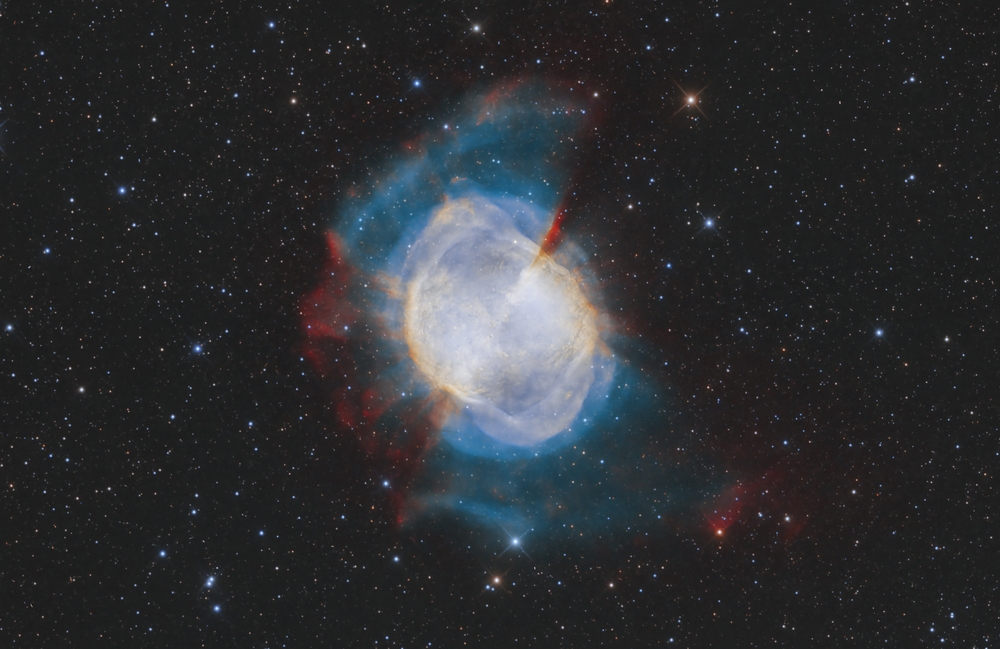Sagitta is a small yet distinctive constellation with an intriguing history and significance. This guide shares what makes this constellation special, how to locate it, its mythological background, and what stars and deep sky objects you can find within it.
Jump to:
- What is the Sagitta Constellation?
- What Does the Constellation Sagitta Represent?
- What Does Sagitta Look Like?
- How Far is the Sagitta Constellation from Earth?
- The Sagitta Constellation Myth
- Sagitta’s Stars
- Nebulae in the Sagitta Constellation
- Finding Sagitta in the Sky
- Fun Facts About Sagitta
- Study Astronomy for £29
Recommended for you!
Best SellersWhat is the Sagitta Constellation?
Sagitta is a small constellation located in the northern hemisphere. Its name comes from the Latin word for "arrow." Despite being one of the smallest constellations, Sagitta has been known and observed since ancient times. It lies in a rich area of the Milky Way, making it a significant point of interest for stargazers.
What Does the Constellation Sagitta Represent?
The constellation Sagitta represents an arrow, which is fitting given its Latin name. Historically, this arrow has been associated with various myths and legends, including the arrow that Hercules used to slay the eagle of Zeus. Though it is not as well-known as some of the larger constellations, its placement near other significant constellations like Aquila and Cygnus adds to its symbolic importance in the night sky.
What Does Sagitta Look Like?

Sagitta is a faint constellation and can be difficult to spot without the help of a star map or telescope. It consists of just a handful of stars arranged in a short, straight line, which resembles the shape of an arrow. The simplicity of its structure makes it unique, but its faintness can be a challenge for amateur astronomers.
How Far is the Sagitta Constellation from Earth?
The Sagitta constellation is located around 400 light-years away from Earth. However, as with most constellations, the individual stars that form Sagitta vary in distance. Some stars within Sagitta are closer to us, while others are much farther away, giving the constellation its place within the vastness of the Milky Way.
The Sagitta Constellation Myth

Sagitta has its roots in various mythologies, with one of the most prominent stories being tied to Hercules. In this myth, Sagitta is said to represent the arrow that Hercules used to kill the eagle of Zeus, which had been tormenting Prometheus. The arrow itself is depicted as flying through the sky, frozen in time. This ancient myth highlights the constellation’s symbolic connection to bravery and justice.
Sagitta’s Stars
The constellation Sagitta contains several notable stars, with three standing out:
- Gamma Sagittae: The brightest star in the Sagitta constellation, Gamma Sagittae is a red giant located approximately 258 light-years from Earth. It sits at the centre of the "arrow" shape, making it a key reference point for identifying the constellation.
- Delta Sagittae: This star is part of a binary system and lies around 450 light-years away. It forms the shaft of the arrow and adds to Sagitta’s structure, helping to define its shape in the night sky.
- Alpha Sagittae: Situated about 470 light-years from Earth, Alpha Sagittae is another important star in the constellation. Although not particularly bright, it contributes to the overall form of Sagitta, marking the tip of the arrow as it flies through space.
Nebulae in the Sagitta Constellation

Sagitta is located near several intriguing deep-sky objects, although the constellation itself doesn’t house any major nebulae. However, its proximity to the rich star fields of the Milky Way means that stargazers can observe nearby nebulae and clusters, such as the Dumbbell Nebula (M27), which lies close to the constellation. This makes Sagitta a great starting point for those exploring surrounding celestial wonders.
Finding Sagitta in the Sky
To get the best view of the Sagitta constellation, it's ideal to observe during the summer months in the northern hemisphere, particularly from July to September. At this time, Sagitta is at its highest point in the sky, making it easier to locate.
Locating Sagitta
Sagitta is nestled between two larger and more noticeable constellations: Aquila and Cygnus. While Sagitta’s stars are faint, its straight, arrow-like formation helps in identifying it. Look for a short line of stars forming the shaft and tip of the arrow.
If you're struggling to spot Sagitta, using a star map or a stargazing app can be incredibly helpful. These tools can guide you to the right part of the sky and help navigate even in areas with light pollution.
Viewing Sagitta with Binoculars or a Telescope
- With binoculars: Sagitta’s stars are faint and may be hard to spot in areas with light pollution. Binoculars will help enhance the view and bring out the delicate line of stars forming the arrow.
- With a telescope: While Sagitta does not have any particularly bright stars, its proximity to other deep-sky objects, such as the nearby Dumbbell Nebula (M27), makes it a rewarding constellation to explore with a telescope.
Best Viewing Conditions
For the best stargazing experience, choose a dark location far from city lights. A clear, moonless night will reveal Sagitta’s subtle beauty. Once you locate the faint arrow, you can fully appreciate this ancient constellation's place in the sky.
Recommended for you!
Best SellersFun Facts About Sagitta
- Sagitta is the third smallest constellation in the sky.
- Despite its size, Sagitta is one of the 48 constellations catalogued by the ancient astronomer Ptolemy.
- The constellation has been associated with various legends, including stories from Greek mythology involving Hercules.
- Sagitta is part of a group of constellations that are rich in celestial objects because of their position within the Milky Way.
Study Astronomy for £29
If the Sagitta constellation has sparked your curiosity, why not explore more about the stars and the cosmos with our Astronomy Diploma Course at Centre of Excellence? This course offers a detailed understanding of the universe, from constellations and star types to the fundamentals of space observation. Perfect for all budding astronomers, the course is available for a discounted price of £29.













